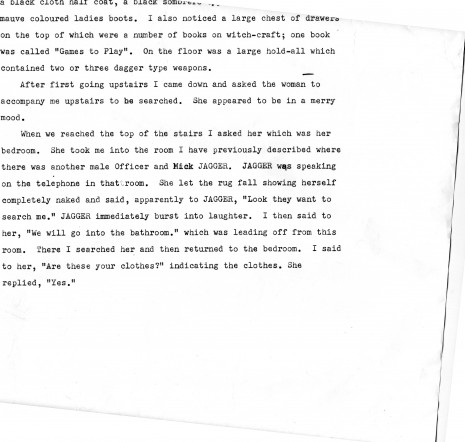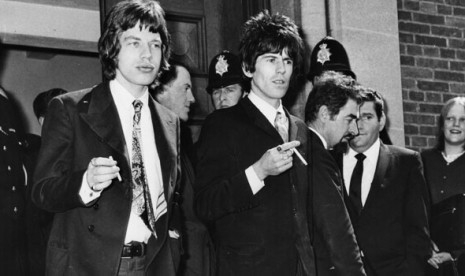
The recent News of the World ‘phone hacking scandal wasn’t the first time the red top used illicit means to obtain stories. Back in the swinging sixties, the paper regularly bartered with the police for information to use in its pages.
One of the News of the World’s tip-offs to the cops led to the most infamous drugs trial of the twentieth century, where Mick Jagger, Keith Richard of The Rolling Stones, and art dealer Robert Fraser were imprisoned in an apparent attempt to destroy the band’s corrupting influence over the nation’s youth.
For the first time, the true story behind the arrests and trial is revealed by Simon Wells in his excellent book Butterfly on a Wheel: The Great Rolling Stones Drugs Bust. Wells’ previous work includes books on The Beatles and The Stones, British Cinema and most recently, a powerful and disturbing biography of Charles Manson. In an exclusive interview with Dangerous Minds, Wells explained his interest in The Stones drugs bust:
‘As a student of the 1960s it was perhaps inevitable that I would collide with the whole Redlands’ issue at some point. Probably like anyone with a passing interest in the Stones, I first knew about it mainly from legend - the “Mars Bar”, the fur rug, the “Butterfly On A Wheel” quote etc. However, like most of the events connected to the 1960s, I was aware that there had to be a backstory, and not what had been passed down into myth. This story proved to be no exception, and hopefully, the facts are as sensational (if not more) than what has passed into mythology. Additionally, as a Sussex boy - I was familiar with the physical landscape of the story- so that was also attractive to me as well.’
Just after eight o’clock, on the evening of February 12 1967, the West Sussex police arrived at Keith Richards’ home, Redlands. Inside, Keith and his guests - including Mick Jagger, Marianne Faithfull, the gallery owner Robert Fraser, and “Acid King” David Schneiderman - shared in the quiet warmth of a day taking LSD. Relaxed, they listened to music, oblivious to the police gathering outside. The first intimation something was about to happen came when a face appeared, pressed against the window.
It must be a fan. Who else could it be? But Keith noticed it was a “little old lady.” Strange kind of fan. If we ignore her. She’ll go away.
Then it came, a loud, urgent banging on the front door. Robert Fraser quipped, “Don’t answer. It must be tradesmen. Gentlemen ring up first.” Marianne Faithfull whispered, “If we don’t make any noise if we’re all really quiet, they’ll go away.” But they didn’t.
When Richards opened the door, he was confronted by 18 police officers led by Police Chief Inspector Gordon Dinely, who presented Richards with a warrant to “search the premises and the persons in them, under the Dangerous Drugs Act 1965.”
This then was the start of the infamous trial of Mick Jagger, Keith Richards and Robert Fraser.
It may seem we all know a small piece of this story, but in fact as Butterfly on a Wheel: The Great Rolling Stones Drugs Bust shows, we’ve never seen the whole picture until now:
‘It was such a well-known story, I was amazed no one had written a book about it before. It’s one of the most incredible stories of the 20th-century and I couldn’t believe that it had been ignored - given that every other angle of the Stones in the 1960s had been thoroughly explored. Obviously, as I worked my way through the story I became aware of just how the mythology of the tale had been constructed over the years. For a decade awash with drugs, it was somewhat predictable that the events that night had been blown up to such a stratospheric level.’
Wells has written a 5 star book, which explains the full background story, bringing new information to the events surrounding the bust, with particular emphasis on the nefarious activities of the News of the World and a dodgy copper, Detective Sergeant Norman “Nobby” Pilcher.
‘I suppose it was predictable during the star-studded 1960s that London’s otherwise anonymous police force would create their own celebrity copper. In this case it was Detective Sergeant Norman Clement Pilcher,’ says Wells. ‘Norman or “Nobby” as he was known to his colleagues was quite a character, as was his insatiable desire to rise swiftly through the ranks of London’s police. Pilcher may well have had an agenda to curb the activities of London’s musicians, but my own take on him was that he knew the value a celebrity bust. While seemingly the majority of the capital’s youth were engaged in some form of narcotic use, Picher knew that busting a celebrity would raise his profile (and by association, his team) enormously.’

Richard Hamilton’s portrait of Mick Jagger and Robert Fraser under arrest.
Pilcher waged a war on pop’s elite. During his time at the Drugs Squad, Pilcher was responsible for arresting Donovan, Brian Jones, John Lennon and George Harrison. Pilcher always got his man, by bringing along to any bust his own supply of evidence. He was lampooned as a rock groupie by underground magazine Oz, and John Lennon described him as ‘semolina pilchard, climbing up the Eiffel Tower’ in “I Am The Walrus.”
In our present world of anodyne music pumped out by record labels and TV talent shows as a soundtrack for malls, lifts, and supermarkets, it is hard to believe that once-upon-a-time, music, in particular pop music, was considered revolutionary and a very real threat to the established order. Think of this when imagining the world The Rolling Stones burst into back in 1963, as it was the Stones, their music and their alleged drug use that became the focus of British establishment’s ire.
‘As far as attitudes towards soft drug use were concerned,’ Simon explains, ‘I would say it was the most important moment of the 20th century. A massive watershed of opinion that for the first time pitched elements of the so-called “Establishment” against the rebellious young - best exemplified in the metaphor of The Rolling Stones. Obviously, once battle lines were drawn it was going to get messy. With the benefit of hindsight, the debate was far too premature – it was only 22 years since the end of WW2 – and obviously many in authority had seen active service and were aghast at the sight of these youngsters strutting their stuff unhindered. Many saw it as an affront.’
Unlike The Beatles, who played the game, and were considered cheeky and harmless, wore suits and smiled, The Stones were deemed dirty, surly, long-haired, and played Black music - R ‘n’ B, that inflamed their fans to riot. All of this wasn’t helped by manager Andrew Loog-Oldham statement if The Beatles were Christ, then The Stones were the Anti-Christ.
Things started to go wrong, after one of The Stones’ riotous gigs, where the famous five had been whisked away from the venue as quickly as possible, but without a toilet break. On the way home, they pulled into a service station, where Bill Wyman asked to use the gents toilet. The garage attendant didn’t like the look of Wyman and his long hair, nor his gurning friends in the back of the van, and refused the bass player access. Jagger and Brian Jones became involved, with Jagger saying he could piss anywhere, which the 3 of them duly did. The incident led to a trial and a fine and was the first hint that someone had The Stones in their sights. If not the Establishment, then rogue elements:
‘I was at pains to point out what really the “Establishment” consisted of during the mid-1960s, and how “they” sought to enact their revenge against Mick, Keith, and Brian. Ultimately, I don’t believe it was men in suits in Westminster discussing the Rolling Stones and plotting their downfall. It’s a hugely romantic image, but it is frankly ludicrous. In reality, there was a Labour government in power who - believe it or not - was attempting to understand the new movement, and equally, were to rationalize drug use through a sweeping review of the arcane narcotic laws that had been in place since the war.
‘However, there were other – less regulated - elements of the so-called establishment that were outraged at the antics by the nation’s youth as exemplified by their defacto leaders- pop groups. Obviously, with The Beatles still the nation’s favorites, The Rolling Stones were an obvious target for sections of the “moral majority” to vent their spleen on. Predictably, it was the News Of The World who decided to infiltrate the Mick and Keith’s core circle and reveal their personal habits to their readership. The papers expose in turn gave the police carte blanch to raid members of the group. Soon, it was open season on musicians – but just not restricted to the UK, but elsewhere too. So the “Establishment” in a sense, yes, but not as many would like to believe.’
There was further rattling of teacups, when Richards purchased a 15th-century house, Redlands, in West Wittering, Sussex. The very thought that a working class guitar player could afford such a posh residence, curdled the milk on the breakfast tables of Middle England.
Add to this the shift in the news away from Wing Commanders and derring-do, to pop groups and hairstyles, saw a growing concern over the fall in the nation’s morals and its role models.
As The Beatles were unassailable, especially after Prime Minister Harold Wilson controversially honored them with MBEs in 1965, the press turned their eye to The Stones for any possible dirt.
Of particular interest was the rise in drug use amongst these young musicians. The News of the World set up a team of journalists to infiltrate The Stones’ circle and get the skinny on their drug use. One night, a journalist spoke with a drug-addled Brian Jones about his chemicals of choice. Thinking they had a major scoop, the paper ran the story. It was to prove a major mistake, as the News of the World couldn’t tell their pop stars apart, and believed they had caught Mick Jagger unawares, rather than Jones. When the paper published its story on Jagger and his alleged drug confession, the singer sued the paper. It led the tabloid to plan its revenge to discredit Jagger.
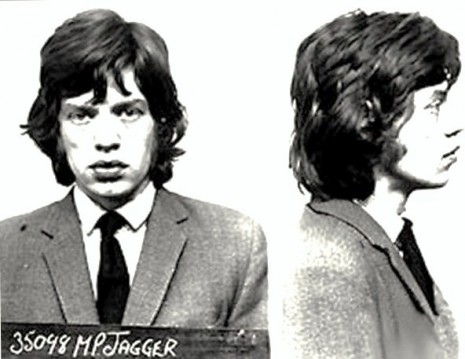
In his book, Wells shows how the News of the World worked hand in glove with the police, tipping off relevant parties about drugs parties, then turning up to photograph the arrested being taken away. He also uncovered the story behind the raid.
‘In fact, through discussions with police in Chichester at that time, they knew about Keith Richards’ presence at Redlands and were also aware that drugs were probably being used there. In fact, a former member of the drug squad told me that they weren’t in the slightest bit interested in raiding Keith’s house as it proves very little, and moreover, throw an enormous spotlight on their operations.
‘The News Of The World was eager to call bluff on Mick Jagger’s libel suit against them and rang Scotland Yard to see if they’d enact a raid on Richards’ house on the weekend of February 12th, 1967. I have it on good authority that the drug squad chief at the time (not Pilcher), balked on the tip-off, saying that it would create a martyrdom status on Mick and Keith if they went ahead with it.
‘Undeterred, the News Of The World then contacted Chichester Police and seemingly forced their hand to make the raid that weekend. When one reads the book, one notices that although Chichester Police had a brief to make any arrests - in fact, they treated everyone with utter respect.
‘Mind you, in London, a line of communication between police and press was actively maintained - as evidenced especially in the raid on John and Yoko during late 1968. Indeed, the press were there just before Pilcher and his team arrived! I’ve been at pains to point out that the Redlands raid was quite a sedate affair (contrary to popular belief) with most of the police personnel made up of village bobbies and part-timers. London’s police were cut from different cloth.
‘As you can imagine, the police who were present on the raid are reluctant to comment on the night’s action. In fact, most rejected my advances. Nonetheless, I was put in contact by someone who was present that night. He had a remarkable memory and was able to fill me in on all the details regarding the planning and the personalities who took part. Contrary to all the other reports that have surfaced, it was a fairly ramshackle caravan of police that descended on Redlands – most of them just village Bobbies and others dragged in from weekend duty the south-coast. I have fastidiously detailed the timeline of events, deducing that the whole raid was planned in just a few hours.’
‘I was able to prove that the NOTW were tapping phones at that point, and paying off informants. In fact lines with NOTW reporters and the Metropolitan police were indivisible. Journalist Trevor Kempson, who elicited the fine detail of the Redlands party, was clearly working closely with police in return for scoops when raids and/or arrests were made. Although, in the case of the Redlands story – Kempson just made the tip-off to Chichester police once Scotland Yard had passed on it.’
The police discovered amphetamines/travel sickness pills in the pocket of Jagger’s jacket. Jagger had obtained the pills in Italy, where they were legally available for travel sickness.
Heroin and 8 capsules of methylamphetamine hydrochloride were found on Robert Fraser, while the remnants of marijuana found in an ashtray implicated Richards.
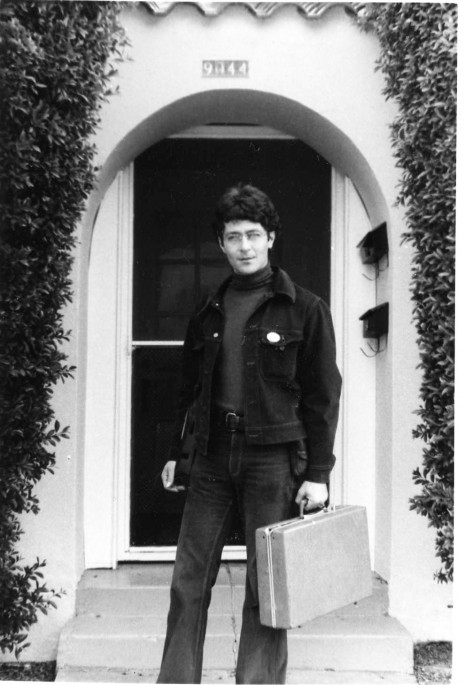
The elusive ‘Acid King’ David Schneiderman
Bizarrely, David Schneiderman’s portable drug cabinet, containing LSD and dope, was not examined by the police, which has given rise to questions over the “Acid King’s” involvement:
‘The elusive David Schneidermann remains probably the most enigmatic figure in rock and roll folklore. Yet, for a tale that hinges so pivotally on the reputed actions of the so-called “Acid King” I had to fully investigate his character; certainly well beyond the mythology that claimed he was working for the CIA, MI5 or some drug enforcement agency. While it would have been nice to have discovered he was some sort of drug dealing double agent, the reality was markedly different, and yet no less interesting. The “Acid King” certainly had a chequered life after Redlands, and I have documented all of his movements following the raid. Suffice to say, he managed to transform himself into many guises- ironically most connected in some way to entertainment.
‘I suppose the one thing that surprised me about writing the book was how the mythology has exceeded the cold facts. Probably not surprising, but the reality was far more interesting than all the imaginary stuff that has been written since. I suppose the most surprising thing is how so many – including many of those at the Redlands party - have bought into the belief that David Schneidermann was some sort of double agent working to destroy them. I suppose the other thing that was of absolutely no surprise was that the antics of the News Of The World were no different to what was occurring up until 2011. I would probably say it was more shocking than surprising and I think many will be aghast that they were up to phone tapping in 1967.’
Not just ‘phone tapping, the tabloids were also guilty of manufacturing vicious and cruel lies, most notoriously the “Mars Bar” allegation and its damaging effects on the innocent Marianne Faithfull or Miss X as she was known in the press.
‘I am convinced that the Redlands raid and the associated fall out served to hasten Marianne Faithfull’s downfall,’ says Wells. ‘In fact, she confirmed this to me during conversations for the book. One has to remember she was just 19, and while quite cocky and brazen, the perception of her struck by the tabloid press courtesy of the “Mars Bar” lie had a debilitating effect on her. I think she just thought that if that’s what people think I am, I’ll be it. Even now, some 45 years later, it is still a very sore point with her.’
‘As far as pop stars and drugs are concerned, I am amazed that in the 40-odd years that have passed since the affair that the press are still as interested in the connection. Despite drug use being absorbed into everyday society (whether that is a good or bad thing), editors still find the connection newsworthy, and that I find rather sad. As for the Establishment as such, I would say that if they really thought the Stones were such a corrupting influence at that point, they would have dealt with the matter in a far more exact and precise way – and not let it run across the world’s papers for the best part of a year. Equally, the globe-trotting the Stones did in 1967 is hardly indicative of the group have their wings severely clipped. Ultimately, the higher echelons of the Establishment saved Mick and Keith – and that’s a point that has been lost on many.’
At their trial, held at West Sussex Quarter Sessions, Jagger and Richards plead not guilty and were defended by Michael Havers QC, a very unlikely hero:
‘Havers is a fascinating character who for me is the hero of the story. At the time he had two teenage sons- Phillip and [the actor] Nigel - who were both Stones fans and played in a band together. This I believe offered him an insight into the mindset of young persons, even if he didn’t really know much about “pop” culture as such. Nonetheless, it should be remembered that Havers failed to win Mick and Keith’s trial in Chichester, although he managed to convince the Appeal Judges in the High Court later on.’
When it came to their trial, Judge Leslie Block advised the jury to ignore any reasonable doubt used by the defense, this saw Jagger sentenced to three months for possession of amphetamines, and Richards to one year in jail for allowing cannabis to be smoked in his home.
Robert Fraser received 6 months for possessing heroin.
The sentencing led to William Rees Mogg, then editor of the London Times writing an editorial in the paper, “Who break a butterfly on a Wheel?” that helped swing public opinion towards the Stones and against the harsh sentencing, which was later quashed on appeal. Wells considers these events “embellished [Mick and Keith’s] notoriety as 20th century martyrs”
‘Given the Stones’ reputation as rock and roll outlaws - the fact that they were seen to have taken on the establishment and won - only helped embolden their reputation. I think both of them put the incident behind them fairly quickly. I dare say things would have been different if they had served out their sentences in prison - I can’t imagine Jagger surviving jail too well.
‘I steered clear of contacting Mick and Keith for quite a few reasons. While it would have been advantageous to have their assistance, my research proved that they have bought into the myth and would be of little help in the direction I wanted to take the story. While it might appear somewhat incredulous, I am not that bothered by speaking with the chief protagonists. I find that the less celebrated characters in these tales have a far greater clarity of thought. When you’re dealing with 40-odd years ago, it is vital to have as clear a recollection as possible. Normally this involves spending more time looking for original documents written as close as possible to the event. Thankfully, for this story I was able to secure a whole cache of official documents from police, courts, and solicitors that offers a totally new view on events.’
Simon Wells has written a definitive account of the events surrounding the Redlands drugs bust, and he puts in a clear and compelling way the extraordinary vendetta organized by the News of the World against The Rolling Stones. Wells’ book also examines the stories behind the drugs bust of Donovan, John Lennon, and George Harrison and most tragically, Brian Jones.
Butterfly on a Wheel: The Great Rolling Stones Drugs Bust can be purchased from Omnibus Press or here.
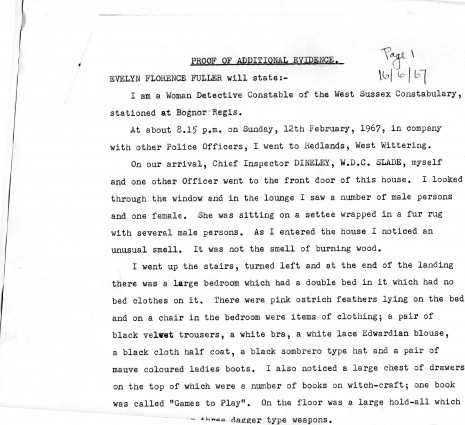
Court documents from the Jagger & Richards’ trial - courtesy of Simon Wells

